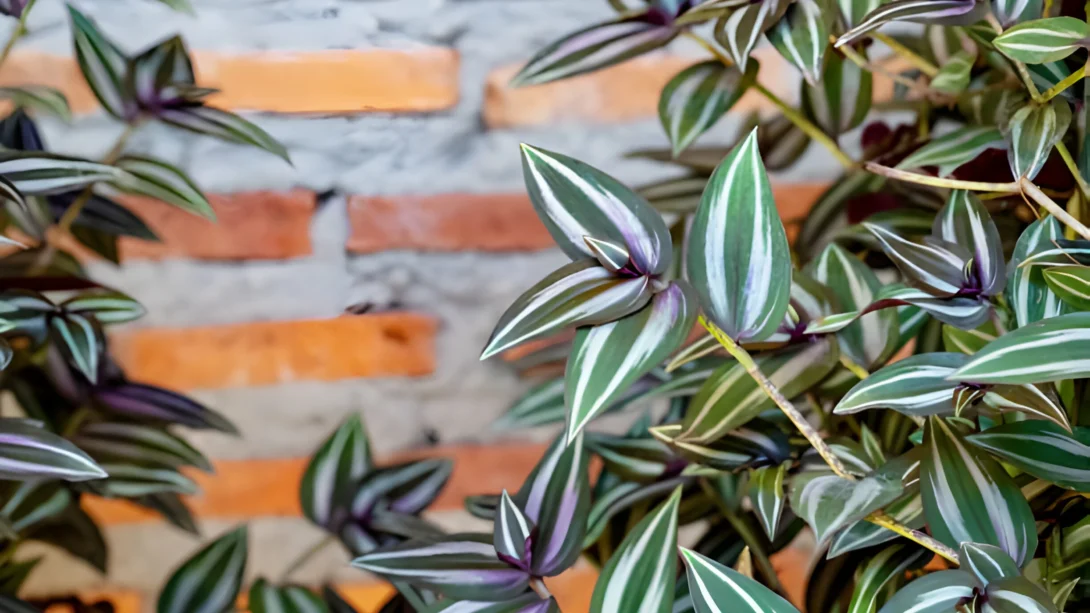Inch plant, scientifically known as Tradescantia zebrina, is a lush, fast-growing vine cherished for its strikingly patterned leaves and ease of care. This plant, often gracing indoor spaces and shaded garden spots, is not only a visual delight but also a prime candidate for propagation. Propagation, the process of creating new plants from an existing plant, stands as a testament to the wonders of gardening, allowing enthusiasts to expand their collection and share with others. The allure of propagating inch plant lies not just in its simplicity but in the joy of watching new growth flourish from your efforts.
Inch Plant
Tradescantia zebrina flaunts a cascade of silver, green, and purple-striped leaves, with a versatility that makes it suitable for hanging baskets, ground cover, or simply as a stunning houseplant. Beyond its aesthetic appeal, inch plant propagation can rejuvenate an older plant, encourage fuller growth, and, most importantly, produce new plants at no extra cost. This section delves into the botanical characteristics and growth habits of the inch plant, laying the groundwork for successful propagation.
Methods of Propagation
Division
One of the most straightforward methods to propagate inch plants is through division. This technique involves separating a mature plant into smaller sections, each with its root system, and repotting them to grow independently. Here’s how to do it:
- Prepare Your Supplies: Gather a sharp knife or garden shears, pots for the new plants, and fresh potting mix. Ensure everything is clean to minimize the risk of infection.
- Remove the Plant: Gently take the parent plant out of its pot, shaking off excess soil to reveal the root ball.
- Divide the Root Ball: Identify natural divisions in the root ball and carefully separate them using your hands or cut through with a knife if necessary. Aim for each section to have several healthy roots and shoots.
- Potting Up: Fill new pots with potting mix and plant each division at the same depth it was growing previously. Water lightly to settle the soil around the roots.
Following division, place the new plants in a location with indirect light and keep the soil moist but not waterlogged. This method is particularly effective in spring or early summer, giving plants ample time to establish before cooler weather.
Stem Cuttings in Water
Propagating inch plant through stem cuttings in water is not only effective but also provides a visual spectacle as roots develop. To ensure success:
- Select Healthy Stems: Look for vigorous, healthy stems about 4 to 6 inches long. Each cutting should have at least one leaf node (the point where leaves attach to the stem), as roots will emerge from these nodes.
- Prepare the Cuttings: Using a clean, sharp knife or scissors, cut just below a node. Remove the leaves from the lower half of the cutting to prevent them from rotting underwater.
- Rooting in Water: Place the stem cuttings in a glass or jar of water, ensuring the nodes are submerged but the leaves remain above water. Place in a bright spot without direct sunlight.
- Transplanting: Once roots are a few inches long, which typically takes a few weeks, gently plant the cuttings in potting soil, and care for them as you would a mature plant.
This method is especially appealing for its simplicity and the ease with which one can monitor root growth, making it an excellent educational tool for gardeners of all ages.
Stem Cuttings in Soil
Another effective method for propagating inch plants involves planting stem cuttings directly into soil. This approach can sometimes be quicker than rooting in water, as it eliminates the need to acclimatize the roots to a different growing medium. Here’s how to successfully propagate inch plants in soil:
- Soil and Pot Preparation: Choose a well-draining potting mix and fill small pots or a propagation tray. Moisten the soil before planting to ensure it’s uniformly damp.
- Prepare the Cuttings: As with water propagation, select healthy stems and cut them just below a node. Remove the lower leaves to expose one or two nodes where roots will form.
- Planting Cuttings: Make a small hole in the soil with your finger or a pencil, and insert the cut end of the cutting into the hole, ensuring at least one node is buried. Gently firm the soil around the stem to support it.
- Creating a Humid Environment: Cover the pot with a plastic bag or place it in a mini greenhouse to maintain high humidity, which is crucial for encouraging root growth. Be sure to open the cover regularly to allow for air exchange and prevent mold growth.
Place the pots in a warm, bright location out of direct sunlight. The soil should be kept moist but not soggy. Rooting typically occurs within 2-4 weeks, after which the plastic covering can be removed, and the young plants can gradually be introduced to more direct light.
Aftercare for Propagated Plants
Once your inch plants have rooted, whether in water or soil, they will require proper care to thrive. Here’s how to ensure your newly propagated plants grow healthy and strong:
- Watering Needs: Young inch plants prefer consistently moist soil, but it’s important to avoid waterlogging. Allow the top inch of soil to dry out slightly before watering again.
- Light Requirements: Position your plants in bright, indirect light. Direct sunlight can scorch the leaves, while too little light may cause leggy growth and diminish leaf coloration.
- Temperature and Humidity: Inch plants thrive in temperatures between 65°F and 75°F (18°C to 24°C). They prefer higher humidity levels, so consider using a humidifier or placing a tray of water near the plants to increase moisture in the air.
- Fertilization: Feed your propagated inch plants with a balanced, water-soluble fertilizer every 4-6 weeks during the growing season. Reduce feeding in the winter months to allow the plants to rest.
Common Problems and Solutions
Even with the best care, you might encounter a few issues when propagating inch plants. Here are some common problems and how to solve them:
- Rotting Cuttings: This is often due to too much moisture. Ensure cuttings are not submerged too deeply in water or soil and that the soil is well-draining. If rooting in water, change the water regularly to keep it fresh.
- Slow Root Development: Lack of warmth or insufficient light can slow down rooting. Consider using a heat mat and ensuring the cuttings receive plenty of indirect light.
- Leaf Loss: A common issue with cuttings, often due to a sudden change in environment. Minimize stress on the plants by gradually acclimating them to new conditions, especially when transitioning from water to soil.
Maximizing Success in Inch Plant Propagation
While the basics of inch plant propagation are straightforward, achieving the lush, vigorous growth that makes these plants so appealing requires attention to detail and a bit of gardening finesse. Here are additional insights to ensure your propagation efforts are as successful as possible:
- Choosing the Right Time: Early spring through summer is the ideal time for propagating inch plants. During these warmer months, the plants are in an active growth phase, which can significantly enhance the success rate of rooting and establishment.
- Use of Rooting Hormone: Although not strictly necessary, applying a rooting hormone to the cut end of your stem cuttings can encourage quicker root development. This is particularly useful for soil propagation, helping to ensure a strong start.
- Monitoring for Pests and Diseases: Keep an eye out for signs of pests or diseases, such as discolored leaves, spots, or webbing on the plants. Early detection and treatment can prevent these issues from spreading to your newly propagated plants and beyond.
Troubleshooting Propagation Issues
Despite your best efforts, you might encounter challenges. Here’s how to troubleshoot some common propagation issues:
- Cuttings Fail to Root: This can be due to several factors, including poor cutting health, incorrect temperature, or inadequate moisture. Ensure your cuttings are from healthy plants, and maintain a consistent environment conducive to root development.
- Mold or Fungus Growth: If you notice mold or fungus on the soil or plant, improve air circulation around the cuttings and reduce humidity levels. Sterilize pots and tools before use to prevent future occurrences.
- Leaf Drop or Yellowing: This may indicate stress, typically from overwatering, under-watering, or sudden environmental changes. Adjust your care routine to better meet the plant’s needs, ensuring a balance of moisture, light, and temperature.
Celebrating Your Propagation Success
Once your inch plants have established themselves, it’s time to enjoy the fruits of your labor. Propagating your plants is not only a cost-effective way to expand your garden but also a rewarding hobby that connects you more deeply with the cycle of plant life. Sharing your propagated plants with friends and family can spread the joy of gardening and inspire others to start their own green-thumb adventures.
FAQs
Q: How long does it take for inch plant cuttings to root?
A: Typically, it takes 2-4 weeks for inch plant cuttings to develop roots, depending on the propagation method and environmental conditions.
Q: Can I propagate inch plants at any time of the year?
A: While you can technically propagate inch plants year-round, the best success rates are achieved in the warmer months of spring and summer when the plants are actively growing.
Q: How often should I water my newly propagated inch plants?
A: Water newly propagated inch plants when the top inch of soil feels dry to the touch. Avoid letting the soil completely dry out or remain soggy, as either extreme can hinder growth.
Conclusion
Propagating inch plant (Tradescantia zebrina) is a fulfilling project that rewards gardeners with stunning new plants for virtually no cost. By following the steps outlined for division, stem cuttings in water, and stem cuttings in soil, you can successfully expand your collection of these vibrant, easy-care plants. Proper aftercare ensures that your newly propagated inch plants thrive, contributing to a lush indoor or outdoor garden space. Remember, patience and attention to detail are key to overcoming common problems and achieving propagation success.


